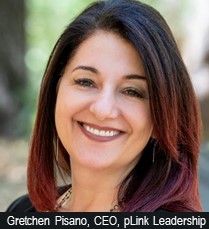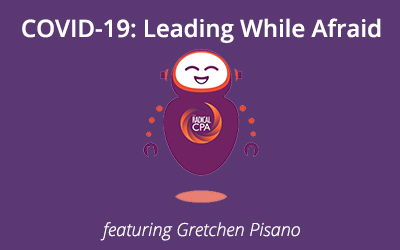The world as we know it is still turned upside down due to the COVID-19 outbreak. About half of the world’s population is staying at home. We’re getting by, but the situation is changing rapidly and I think we can all agree that we might be a little scared right now. That’s ok.
Over the past two weeks, my social media followers have been listening in to live interviews about virtual leadership and COVID-19. After another great conversation with Gretchen Pisano, CEO of pLink Leadership, we learned about how to lead while afraid.

CPA firms are almost more prone to anxiety because we’re like financial doctors. The problem is that we’ve never really been trained in how to deal with the emotional ramifications of advising clients.
Fearless leadership seems to be an oxymoron these days. The question is, how do we control the fear and become the leaders that our firms, our team members, and our clients need right now? In my last interview with Gretchen, I asked her about whether fear is healthy and how we can avoid getting to a point where we’re afraid to decide, where we become paralyzed by fear.
Leadership is supposed to be fearless, but where we are now with COVID-19 is that we’re immersed in the shared experience of human suffering. It’s widespread and magnified and creating an environment where leadership is anything but fearless. Is it okay to be afraid?
The answer is: YES! And anyone worth their salt as a leader is afraid right now. Healthy doses of fear let us know that we’re really leading and leading on the edge. Gretchen explained that fear is not the problem. It’s what people do to themselves to pretend like they’re not afraid that causes all sorts of other problems. Recognize and feel the fear, but don’t take it out on other people and don’t bottle it up and act like it doesn’t exist.
It’s very important in times like this to be present for people. We don’t have a crystal ball; we don’t know which direction this will go. But you can rest assured that there will be opportunities and shifts that open up new pathways forward. And those are the kinds of things that you can keep your people focused on as we’re all mitigating the down-side of things in the short-term.
As CPAs and accountants, we’re typically ‘preparers.’ We like numbers and data, they’re reliable, and we know how to make sense of them. But with COVID-19, or any crisis, we have no idea what’s next, and that makes us very uneasy. This is normal. What can we do as leaders to prepare for the unknown? The other question is how do you know what you should be controlling versus what you shouldn’t be?
In the short-term, here’s an example of what this could look like. You can control your daily schedule: when you get up, what you eat for lunch, when you exercise, and how much you drink (don’t rely on it as a coping mechanism, friends!). You can’t control the news, but you CAN control how you interpret it.
You CANNOT control what happens after you help a client submit documents for a disaster assistance loan. You can’t control that SBA processes were never set up for this on such a large scale. You cannot control when the website is up and when it’s not. You CAN follow up via phone. You also can get in touch with your peers via associations to see what the group experience has been. See the difference?
The idea here is not to try to force fit a new reality into an old infrastructure. In the example above, you can ask yourself how you would have handled it in normal circumstances. Mitigate as much risk as you can while still taking action.
There is anxiety around risk and figuring out how to move forward. There’s no checklist; we don’t know where to start and there’s no guidance. So how can we balance the risk of not knowing with what we DO know? First understand that there are two kinds of risk here: the risk of doing noting and the risk of taking action.
You do nothing, and you risk losing out, not just for you but for your clients. You do something, and you risk being wrong. So, decide what you can do today. You might not know what next week will bring, but what is your next step, right now? As CPAs and accountants, we can be there for our clients right now and give them different scenarios based on your subject matter expertise. If they do this, then the outcome could be this, but if they go another route, the outcome could maybe be something else. In this way, you are also giving your clients autonomy and the power of choice.
Going back to our profession’s love of checklists and organizers, one way to think about advising clients in a COVID-19 environment is that you give them three ways to approach a situation. There will probably be three different buckets of information during this conversation: what you know for sure, what you don’t know, and what you know you wouldn’t do and why. But at the end of the day, it’s the client’s job to make the decision. This is called scenario planning, and it can provide that little bit of framework that CPAs might need to make decisions in a fear-based environment.
This is part of a larger conversation about the movement toward value-based CPA services. It’s a shift toward judgment-based counsel as opposed to rules-based. We don’t tell people what to do and we don’t give advice. Instead, we help clients find their way back to their own best counsel. At the end of the day, your clients want to have a conversation with you. They want to feel like they’re talking to someone who knows just a little bit more than they do and can help them identify the risk points and the benefits. It’s important to help clients understand there is not a single right answer in a volatile environment.
What we’re talking about here is best practices versus next practices.
As CPAs, we can kind of define that risk tolerance for your clients.
If you’re not used to knowing your clients in this way, it’s time for a shift of mindset and approach. You’ll need to get used to getting information from your clients in a different way than in the past. Then, you’ll need to take that information to your team and facilitate some conversations about the different approaches. Spread the work around; it’s too exhausting for the partner to do all this work. Teach the managers and junior staff to have some of these conversations, too. The result is a new advisory approach that builds next practices around best practices.Â
Here are three or four questions you can start out with if you’re unfamiliar with how to have this type of conversation with your client. Start out with “how are you today, really?†Lead into “what is most important to you to protect in the next 12 to 14 months or so?†(or another timeline appropriate for your client.) Next, “what’s on your mind at 3 in the morning?†Then you can go into the types of questions that CPAs are more familiar with, like cash flow, things like that. You can use this opportunity to talk to your clients about where there might be opportunities for new value – again, being an advisory CPA offering value-based service, not just checking the boxes.
The key is to ask the right questions. Clients don’t know what to ask. They don’t know what they don’t know. This goes back to my very first interview with Gretchen, that there aren’t any road maps right now. You’ll try to map this to previous experiences, like World Wars or the Depression, but it’s not the same. We’re more resilient now than we were then in a lot of ways. We have ways of keeping commerce going that we didn’t have when those things were happening. So that’s a positive thing to hold onto.
One of the things that Gretchen said she’s hearing from executives right now is a desire to get back to where they were before. People want to feel like they’re standing on stable ground. It will be important over these next 30 or 60 days or so to remain flexible. Don’t try to be locked into a particular position. Know that things can and probably will change almost daily sometimes. Focus less on being right. Lean into the volatility and demonstrate value and expertise with superfluid thinking.
If you can take just one thing back to your firm today, try to remember that while we can’t see very far into the future, we do know how to put one foot in front of the other.
You can watch the full interview below and get more insights into how to lead while afraid.

0 Comments